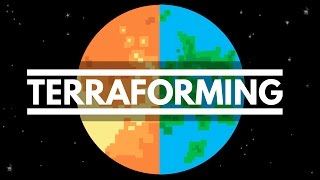(单词翻译:单击)
Hey there! Welcome to Life Noggin!
大家好!欢迎来到脑洞大开的生命奇想!
As we blow through the resources on Earth, it's clear that we're going to need a new planet soon.
我们快用光地球上的资源了,很明显我们很快就需要一个新的星球。
And since there isn't another Earth out there, is it possible we could make one through terraforming?
既然地球上没有另一个地球,我们有可能通过改造其他行星形成一个地球吗?
Terraforming is the process of turning a hostile environment into one that can support human life.
地球化是将恶劣的环境优化到能够供人类生活的过程。

And a possible place where this could happen is Mars.
最有可能的地方是火星。
After all, it's literally right there, and it might be a good replacement for Earth.
毕竟,它就在那里,可能是地球的一个很好的替代品。
So what do we have to work with?
那么我们需要做些什么呢?
Well, Mars' atmosphere is really thin, so only about one percent of what we have on Earth.
嗯,火星的大气层非常稀薄,只有地球上的百分之一。
And it's carbon dioxide, so toxic to humans.
它的二氧化碳,对人类是有毒的。
Mars is also further from the Sun and that coupled with its thin atmosphere means it's about -63 degrees Celsius.
火星也离太阳更远,加上它大气层稀薄,意味着它的表面温度大约是-63摄氏度。
So, sorry folks, your winter coats won't cut it.
所以,对不起大家,你们的冬衣不够用了。
On top of that, Mars also has no magnetosphere so no protection against radiation.
最重要的是,火星也没有磁层,所以没有辐射防护。
And it also has about one-third of the gravity we feel on Earth.
它只有地球上三分之一的重力。
So, clearly, there's a lot we'd need to change.
所以,很明显,我们需要改变很多。
Let's start with the atmosphere.
我们从大气开始。
We'd have to make it thicker and change its composition.
我们必须让它变厚,改变它的成分。
One way to do this would be to trigger a greenhouse effect, making it so any heat from the Sun is trapped, heating the planet all over.
一种方法是触发温室效应,保存太阳的热量,从而使整个星球升温。
We could do this a bunch of different ways, like using methane mined from the rocks on Mars, carbon dioxide -- if we could get enough of it, or even with ammonia!
我们可以用很多不同的方法来做,比如利用火星上岩石上的甲烷,二氧化碳——如果我们能得到足够的甲烷,甚至用氨水都行!
Let's focus on that one for a minute.
来仔细了解一下这一点。
We could release that ammonia by smashing ice-rich comets from the outer Solar System.
我们可以通过粉碎外太阳系富含冰的彗星来释放氨。
And since ammonia is mostly nitrogen by weight, once we add oxygen through plant life, we could have an atmosphere pretty similar to Earth's!
由于氨主要是氮的重量,一旦我们通过种植植物加入氧气,我们就可以有一个与地球相似的大气层!
And with that thicker atmosphere, the atmospheric pressure would be high enough for humans to possibly live.
由于大气层更厚,大气压力就会高到足以让人类生存。
From here, the atmosphere will warm the planet and the rest of the terraforming job will be a relative cakewalk.
从这里开始,大气层将会为行星加温,而其他的地球化工作将会相对容易。
We can melt Mars' polar ice caps and have water, and with that water we can have the environment for life, make some changes to the Martian soil, and set up shop on the formerly red planet.
我们可以融化火星的极地冰帽,这样就有了水,然后我们可以拥有生命生存的环境,对火星土壤做一些改变,并在原来的红色星球建立商店。
But wait, there is more! Remember the whole "Mars has no magnetosphere" thing?
但是等等,还有!还记得“火星没有磁层”吗?
Turns out, that's a big part of why Mars lost its atmosphere in the first place.
事实证明,这是火星失去大气层的首要原因。
Mars' global magnetic field shut down around 4.2 billion years ago, and from there the solar wind and powerful sun explosions stripped away most of the atmosphere, sending it off into space.
火星的全球磁场在大约42亿年前就关闭了,从那时开始,太阳风和强烈的太阳爆炸把大部分大气都带到太空了。
And that's not good, since that means there isn't a trove of carbon dioxide in the Mars rocks to release in order to trigger a greenhouse effect.
这并不是好事,因为这意味着在火星岩石中没有大量的二氧化碳可以释放,因而无从引发温室效应。
And also, any atmosphere we do add on Mars won't last.
而且,我们在火星上添加的任何大气层都不会持久。
Eventually, it'll be stripped away by radiation and solar wind, too.
最终,它也会被辐射和太阳风带走。
And what ever worsen would be hard to hold onto with Mars' weaker gravity.
而且更糟的是,如果火星的引力减弱,我们就很难坚持下去。
So, Mars isn't the best option.
所以,火星不是最好的选择。
Instead, let's check our other nearest neighbor: Venus.
那么,让我们看一下最近的邻居:金星。
Venus has a super-thick atmosphere and temperatures around 460 degrees Celsius so we'd have to change a lot of that, too.
金星的大气层非常厚,温度大约在460摄氏度,所以我们也需要改变很多。
One option is to bombard Venus with hydrogen from gas giants, creating graphite and water that would turn into global oceans.
一种方法是用来自气态巨行星的氢来轰击金星,制造碳纤维和水,然后变成全球海洋。
These would dissolve produced nitrogen and lower the atmospheric pressure to something more Earth-like.
它们会溶解产生的氮,降低大气压力,使之更像地球。
We could also terraform parts of Mercury.
我们也可以把水星的一部分地球化。
There's water and organic molecules in the northern polar region, so heating the bottoms of big craters with mirrors could melt the ice.
北极地区有水和有机分子,所以用镜子加热大陨石坑底部可以融化冰。
And adding a dome on top could create a little life-bubble on a hostile planet.
在环境恶劣的星球上增加一个圆顶可以创造一个小小的生命泡泡。
The same thing could be done on the Moon, too.
同样的事情也可以在月球上完成。
Hopefully that life-bubble has Wi-Fi.
希望生命泡泡有Wi-Fi。
We don't want you to miss out on Life Noggin... We could maybe terraform Europa. Well, sort of.
我们不想让你错过我们的节目。我们也许可以将木卫二地球化。嗯,差不多。
If we could melt the surface ice, some of the released oxygen could populate the atmosphere and we could have a water world on our hands, people.
如果我们能融化表面的冰,一些释放出来的氧气就会填充进大气层,我们就得到一个水世界。
And it's even possible to terraform Titan, too, but we would also have to create oxygen and make the moon less toxic to humans.
甚至也可能改造土卫六,但我们也必须创造氧气,降低月球对人类的危害。
But all this is really hard and really far off to the future.
但所有这些都是非常困难的,而且非常遥远。
While I'd love to call another place in this universe my home, we should probably just protect the Earth we have now.
虽然我很想把这个宇宙的另一个地方当作我的家,但是我们应该保护我们现在拥有的地球。
So what do you think? Should we start terraforming other planets?
你怎么想的?我们应该开始改造其他行星吗?
This video was written by space historian Amy Shira Teitel. She makes a new video every week on her channel, and you HAVE to check them out!
这段视频由太空历史学家艾米·希拉·泰特尔撰写。她每周都在她的频道上做一个新的视频,你必须去看看!
There's a link in the description if you're on mobile.
如果你是在手机上看的话,描述区中有一个链接。
Should the United States have been completely blindsided by the launch of Sputnik?
美国是否完全被“伴侣号”的发射所击败?
Why is it that the Germany launches look nothing like any of the other launches we're used to seeing?
为什么德国发射的航天器与我们以前看到的其他航天器没有任何相似之处?
What changes did NASA make to avoid a repeat of Apollo 13's near-fatal disaster?
为了避免阿波罗13号那种几乎致命的灾难,美国宇航局做出了哪些改变?
How did these two spacecraft actually dock up to become this one spacecraft?
这两艘宇宙飞船是如何对接下来成为宇宙飞船的?
How did NASA get pictures of Neil Armstrong walking down the lunar modules ladder if there was nobody already on the moon to operate the camera?
如果没有人在月球上操作照相机,美国宇航局是如何拍到尼尔·阿姆斯特朗走下月球舱梯的照片的?
There's a link in the description if you're on mobile. As always, I'm Blocko! This has been Life Noggin. Don't forget to keep on thinking!
如果你是在手机上看的话,描述区中有一个链接。我是宝高,这里是脑洞大开的生命奇想!思考不要停!


